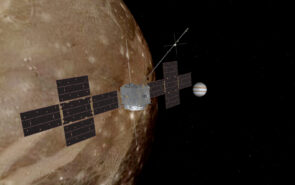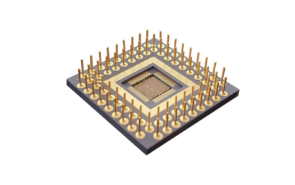With the launch of ESA’s Jupiter Icy Moons Explorer (JUICE for short) on 14.04.2023, IHP technology from Frankfurt (Oder) has also embarked on the more than one billion km long journey to Jupiter. Two circuits developed at IHP are among the core components of the Chirp Transform Spectrometer, developed by the Max Planck Institute for Solar System Research (MPS), which can determine the composition of Jupiter’s stratosphere, for example, by analysing spectra. The measuring instrument is one of numerous instruments with which detailed observations of Jupiter and its three large moons Ganymede, Callisto and Europa are to be carried out.
For space applications, in addition to radiation resistance, the reduction of size, weight and power consumption of the individual components is important. Tiny integrated circuits help improve the spectrometer developed by the MPS compared to its predecessor. The IHP has designed and manufactured a chirp generator circuit in the in-house 0.13 µm SiGe BiCMOS technology. This generates a chirp signal, which is necessary for the functionality of the spectrometer. The digitisation, calculation and storage of the spectral power values is handled by another chip: the two-channel analogue-to-digital converter was designed in collaboration with the Institute for Electrical and Optical Communications Engineering at the University of Stuttgart. “Our work over the past years makes an important contribution to the spectrometer and thus to achieving the goals of the entire JUICE mission,” says IHP project manager Dr Philip Ostrovskyy. Scientists from the Circuit Design and System Architectures departments worked together with experts from IHP’s Technology Department. “A circuit like this is always a collaborative effort, within IHP as well as with partners and clients,” the expert explains.
The Scientific-Technical Director of the IHP, Prof. Dr. Gerhard Kahmen, emphasises the importance of the development: “The circuits and their use in an important measuring instrument for an interplanetary space mission are an outstanding result of our institute. They contribute significantly to establishing IHP as a partner for radiation-resistant technologies.” After all, this is not the first time IHP technology has been used in space. The Frankfurt research institute has been developing radiation-resistant circuits for years and offers them as part of the MPW service.
Further information on ESA’s JUICE mission: JUICE-Mission (external link!)
Image 1: The IHP chips are part of a spectrometer that is part of the various measuring instruments of JUICE and will study Jupiter and its moons. (Source: ESA | ATG Medialab))
Image 2: For testing: The 6mm x 6mm chirp generator chip was designed and manufactured at IHP. It was mounted in a housing for the radiation test. (Source: IHP)
About IHP:
The IHP is an institute of the Leibniz Association and conducts research and development on silicon-based systems, radio frequency circuits and technologies, including new materials. It develops innovative solutions for application areas such as wireless and broadband communication, security, medical technology, Industry 4.0, mobility and space travel. The IHP employs about 350 people. It has a pilot line for technological developments and the preparation of high-speed circuits with 0.13/0.25 µm SiGe BiCMOS technologies, located in a 1500 m² DIN EN ISO 14644-1 3 clean room.







